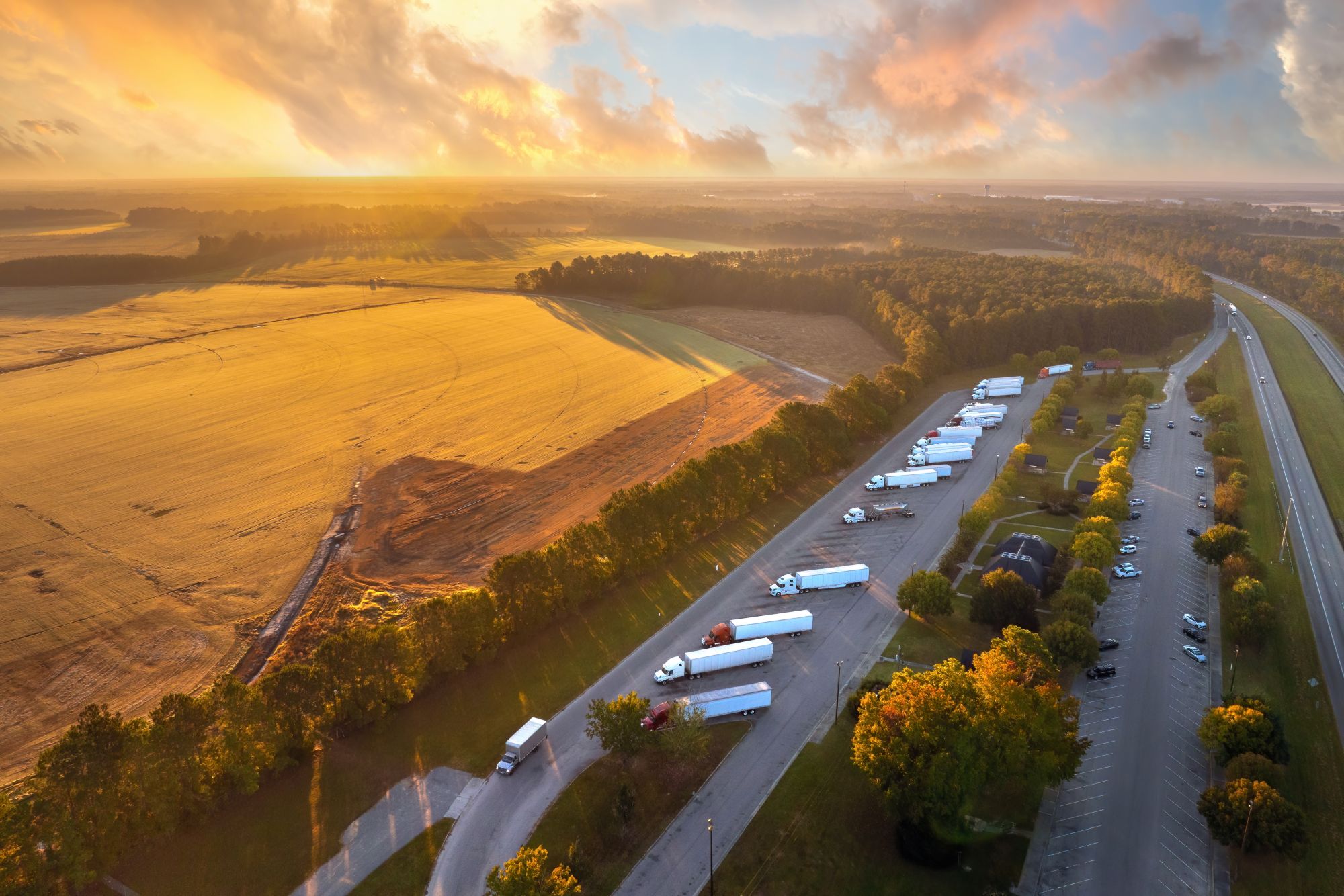
Susie Jones
Autonome Lkw: Der Weg in die Zukunft ist unübersichtlich
Erstellt: 16.05.2025
•
Aktualisiert: 23.05.2025
Autonome Lastkraftwagen - für manche eine beängstigende Vorstellung, aber anscheinend die Zukunft der Logistikbranche. Mit den technologischen Fortschritten in diesem Sektor ist die Aussicht auf teil- oder vollautonome Fahrzeuge, die Ihre Waren ausliefern, groß. Nach Angaben der britischen Regierung könnte dies sogar schon 2026 der Fall sein, da im Mai 2024 das Gesetz über automatisierte Fahrzeuge (Automated Vehicles, AV) in Kraft tritt.
Doch was passiert, wenn ein autonomer Lkw in einen Unfall verwickelt wird? Wer ist haftbar? In diesem Blog befassen wir uns mit der Welt der Autonomie, wie sie sich auf den Mobilitätssektor auswirken könnte, wer bei Unfällen haftet und was die Fahrer von dieser Veränderung halten.
Welches sind die verschiedenen Stufen der Automatisierung?
Es gibt sechs Stufen der Automatisierung des Fahrens:
Stufe 0 - Keine Automatisierung. Der Mensch führt alle Fahraufgaben aus.
Stufe 1 - Fahrerassistenz. Das Fahrzeug verfügt über ein einziges automatisiertes System.
Stufe 2 - Teilweise Automatisierung. Das Fahrzeug kann lenken und beschleunigen. Ein Mensch überwacht jedoch weiterhin alle Aufgaben und kann jederzeit die Kontrolle übernehmen.
Stufe 3 - Bedingte Automatisierung. Das Fahrzeug kann die meisten Fahraufgaben übernehmen. Der Mensch muss jedoch noch eingreifen.
Stufe 4 - Hohe Automatisierung. Geofencing ist erforderlich, und das Fahrzeug kann unter bestimmten Umständen alle Fahraufgaben übernehmen. Menschliche Übersteuerung ist eine Option.
Stufe 5 - Vollautomatisierung. Das Fahrzeug führt alle Fahraufgaben unter allen Bedingungen aus. Es ist keine menschliche Aufmerksamkeit oder Interaktion erforderlich.
Wie funktionieren autonome Lkw?
Sensoren, Kameras und künstliche Intelligenz ermöglichen es autonomen Lkw, selbstständig zu fahren. Fortschrittliche Programme treffen Entscheidungen anstelle von menschlichen Fahrern.
Die Probleme, die auf die Industrie zukommen könnten
Rechtliche Aspekte - Wer ist bei Unfällen haftbar? Ist es der Fahrer, sein Arbeitgeber oder das Wartungsunternehmen? Darauf gehen wir im Folgenden ein.
Infrastruktur - Unsere bestehenden Straßen sind für eine Welt mit Benzinmotoren gebaut. Daher muss die Infrastruktur aufgerüstet oder ersetzt werden, um selbstfahrende Fahrzeugflotten zu unterstützen, was Geld und eine beträchtliche Menge politischen Willens erfordert.
Gesellschaftliche Veränderungen - Auch die Einstellung der Öffentlichkeit muss sich ändern. Die Aussicht auf KI-Fahrzeuge ist für viele abschreckend. Sie haben Bedenken hinsichtlich der Sicherheit, der Fahrtenüberwachung und der rechtlichen Grauzonen bei Verkehrsunfällen.
Sicherheit - Ein System, das sich auf digitale Netze stützt, ist anfälliger für Cyber-Bedrohungen.

Was halten Lkw-Fahrer von autonomen Lkw?
Die Sicherheit autonomer Lkw ist ein heiß diskutiertes Thema in der Branche. Viele diskutieren darüber, ob die Technologie einen zuverlässigen Standard hat, um mit unvorhersehbarem Wetter umzugehen und Hindernisse zu erkennen - etwas, das die Lkw-Fahrer auf den Social-Media-Seiten von SNAP mit Sorge betrachten:
"Bei dem kleinsten bisschen Regen verliert mein Lkw alle Automatikfunktionen, AEBS und den Tempomat. Es kann nicht sein, dass Lkw in absehbarer Zeit ohne Fahrer selbst fahren dürfen."
"Das wird mehr Menschen auf den Straßen töten und mehr Staus verursachen. Denken Sie nur daran, wie zuverlässig die Elektronik in Ihrem Euro-6-Fahrzeug ist. Die gleichen Leute machen auch autonome Lastwagen".
Rechtliche Aspekte - wer ist verantwortlich, wenn ein Unfall passiert?
Im Falle eines Unfalls kann die Verantwortung zwischen dem Fahrer und dem Hersteller wechseln. Das Gericht muss feststellen, ob ein Unfall durch einen technischen Fehler, unzureichende Wartung oder einen Fahrfehler verursacht wurde.
Herstellerhaftung
Der Hersteller haftet in den folgenden Fällen: - Fehlfunktion des Sensors
Software-Störungen
Unzureichende Cybersicherheitsmaßnahmen
Unzureichende Tests
Fahrer/Flottenhaftung
Ein Fahrer eines autonomen Lkw kann für einen Unfall haften, wenn er die für den ordnungsgemäßen Betrieb des Fahrzeugs erforderliche Wartung vernachlässigt - man könnte argumentieren, dass diese Haftung auch für Flottenmanager gelten könnte.
Trotzdem herrscht unter den Akteuren des Mobilitätssektors noch einige Verwirrung. Wir haben Lkw-Fahrer auf unseren [Social-Media-Seiten] (https://www.facebook.com/snapaccount?locale=en_GB) gefragt, wer ihrer Meinung nach im Falle eines Unfalls mit einem autonomen Fahrzeug haftbar gemacht werden könnte. 51 % der Fahrer waren der Meinung, dass der Fahrer verantwortlich sei, 37 % nannten die Hersteller von automatisierten Fahrzeugen und 12 % die Softwareentwickler.
Es liegt auf der Hand, dass in der Branche noch Klärungsbedarf besteht, bevor autonome Lkw zum festen Bestandteil unserer Straßen werden.
Wie sieht die Zukunft aus?
In seiner neu aufgelegten Kampagne [TruckPark of the Future] (https://snapacc.com/truckpark-2049/) wirft SNAP einen Blick auf die Zukunft des Mobilitätssektors. Im Zuge des technologischen Fortschritts werden autonome Fahrzeuge eine wichtige Rolle in der Branche spielen, wobei eine 50 %ige Chance besteht, dass Maschinen in den nächsten 120 Jahren alle menschlichen Arbeitsplätze übernehmen könnten.
Aber wie werden sie mit einigen der gefährlichsten Autobahnen Europas umgehen?
Beim Lkw-Fahren geht es um mehr als nur um das Sitzen hinter dem Lenkrad - oft geht es darum, die sich ständig ändernden und unvorhersehbaren Straßenverhältnisse zu bewältigen. Es stellt sich die Frage, ob autonome Lkw mit einigen der schlechtesten Straßen in Europa zurechtkommen könnten. Im Rahmen der jüngsten Kampagne [Hazardous Highways] (https://snapacc.com/hazardous-highways/) hat SNAP die gefährlichsten Straßen Europas ermittelt, wobei die Ergebnisse zeigen, dass Bulgarien, Litauen und die Tschechische Republik die größten Probleme aufweisen.
Man könnte argumentieren, dass autonome Lkw beim Versuch, einige dieser Straßen ohne menschliches Zutun zu befahren, vor Herausforderungen stehen werden. Begrenzte GPS-Genauigkeit, Sensorstörungen und ein Mangel an konsistenter Infrastruktur könnten die Dinge erschweren.



